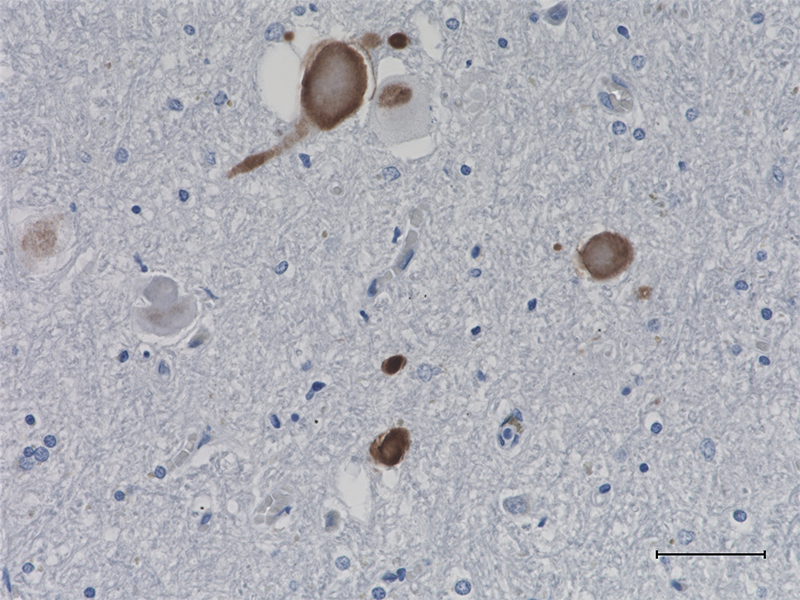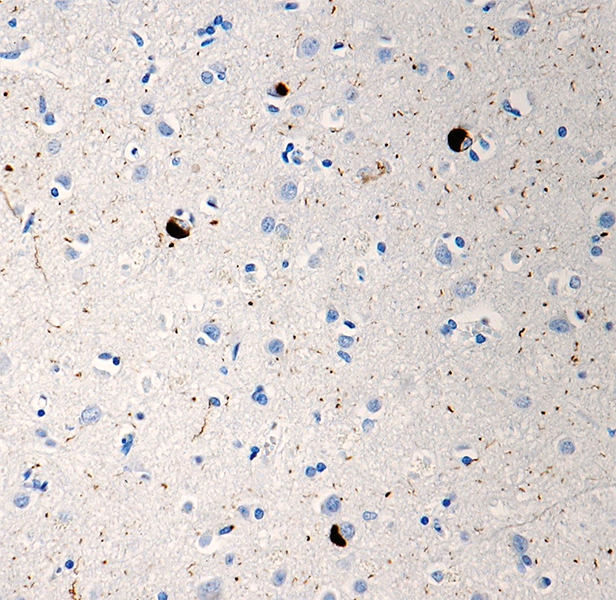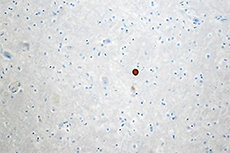- Clone
- 4B12/Synuclein (See other available formats)
- Regulatory Status
- RUO
- Other Names
- NACP, PARK1, PARK4, PD1, Synuclein alpha-140, non-A4 component of amyloid, alpha-synuclein, isoform NACP140, non-A beta component of AD amyloid Parkinson disease
- Previously
-
Signet Catalog# 9730-02
Signet Catalog# 9730-05
Signet Catalog# 9730-10
Covance Catalog# SIG-39730
- Isotype
- Mouse IgG1, κ
- Ave. Rating
- Submit a Review
- Product Citations
- publications

-

IHC staining of purified anti-α-Synuclein, 103-108 antibody (clone 4B12) on formalin-fixed paraffin-embedded Parkinson's disease human brain tissue. Following antigen retrieval using 70% formic acid for 20 minutes at room temperature, the tissue was incubated with 1 µg/ml of the primary antibody overnight at 4°C. BioLegend´s Ultra-Streptavidin (USA) HRP kit (Multi-Species, DAB, Cat. No. 929901) was used for detection followed by hematoxylin counterstaining, according to the protocol provided. The image was captured with a 40X objective. -

IHC staining of purified anti-α-Synuclein, 103-108 antibody (clone 4B12) on formalin-fixed paraffin-embedded Parkinson's disease human brain tissue. Following antigen retrieval using 70% formic acid for 20 minutes at room temperature, the tissue was incubated with 2.5 µg/ml of the primary antibody overnight at 4°C. BioLegend´s Ultra-Streptavidin (USA) HRP kit (Multi-Species, DAB, Cat. No. 929901) was used for detection followed by hematoxylin counterstaining, according to the protocol provided. The image was captured with a 40X objective. -

Western blot of purified anti-α-Synuclein, 103-108 antibody (clone 4B12). Lane 1: Molecular weight marker; Lane 2: 20 µg of human brain lysate. The blot was incubated with 1 µg/mL of the primary antibody overnight at 4°C, followed by incubation with HRP labeled goat anti-mouse IgG (Cat. No. 405306). Enhanced chemiluminescence was used as the detection system.
α-Synuclein is expressed principally in the nervous system, but it is also produced in other tissues, including the skin. In the brain, the protein is primarily neuronal, but it is also present in glia. Neuronal α-synuclein is concentrated in presynaptic nerve terminals, interacts with plasma membrane phospholipids, and is also present in nuclei and mitochondria. At least three isoforms of synuclein are produced through alternative splicing. The most common isoform is a 140 amino acid-long transcript. Other isoforms are a-synuclein-126, lacking residues 41-54; and α-synuclein-112, which lacks residues 103-130. α-Synuclein’s physiological role is poorly understood, but the protein has been implicated in regulating dopamine release and transport, synaptic vesicle clustering, and functioning as a SNARE-complex chaperone. α-Synuclein fibrils are major component of the intracellular Lewy bodies that are associated with Parkinson's disease, Lewy body dementia, and multiple system atrophy.
Product DetailsProduct Details
- Reactivity
- Human
- Antibody Type
- Monoclonal
- Host Species
- Mouse
- Immunogen
- This antibody was developed using a purified, E. coli produced human α-synuclein.
- Formulation
- Phosphate-buffered solution (no preservatives or carrier proteins).
- Preparation
- The antibody was purified by affinity chromatography.
- Concentration
- 1 mg/mL
- Storage & Handling
- This antibody should be handled aseptically as it is free of preservatives such as Sodium Azide. Store this antibody undiluted between 2°C and 8°C. Please note the storage condition for this antibody has been changed from -20°C to between 2°C and 8°C. You can also check the vial label or CoA to find the proper storage conditions.
- Application
-
IHC-P - Quality tested
WB - Verified
ELISA - Reported in the literature, not verified in house - Recommended Usage
-
Each lot of this antibody is quality control tested by formalin-fixed paraffin-embedded immunohistochemical staining. For immunohistochemistry, a concentration range of 1.0 - 2.5 µg/mL is suggested. For Western blotting, the suggested use of this reagent is 1.0 - 10.0 µg per mL. It is recommended that the reagent be titrated for optimal performance for each application.
- Application Notes
-
This antibody reacts with human a-synuclein. It does not react with mouse or rat a-synuclein. The epitope lies within amino acids 103-108 of a-synuclein.
Additional reported applications (for the relevant formats) include: ELISA2, Western blotting1,2,3,4,6,8, and immunoprecipitation4. -
Application References
(PubMed link indicates BioLegend citation) -
- Lahut S, et al. 2017. Dis Model Mech. (WB) PubMed
- Landeck N, et al. 2016. Mol Neurodegener. 11(1): 61. (ELISA, WB) PubMed
- Moussaud S, et al. 2015. Expert Opin Ther Targets. 19(5): 589. (WB) PubMed
- Helferich AM., et al. 2015. Mol Neurodegener. 10(1): 66. (IHC, IP, WB) PubMed
- Bodis‐Wollner I, et al. 2014. Ann Neurol. 75(6): 964. (IHC)
- Shen W, et al. 2014. J Neurochem. 129(5): 884. (WB)
- Fagerqvist T, et al. 2013. J Neurochem. 126(1): 131. (IHC)
- Ebrahimi-Fakhari D, et al. 2011. J Neurosci. 31(41): 14508. (WB) PubMed
- Welander H, et al. 2011. Biochem Biophys Res Commun. 412(1): 32. (IHC)
- Product Citations
- RRID
-
AB_2564729 (BioLegend Cat. No. 807803)
AB_2734561 (BioLegend Cat. No. 807804)
AB_2564730 (BioLegend Cat. No. 807801)
AB_2564731 (BioLegend Cat. No. 807802)
Antigen Details
- Structure
- α-Synuclein’s canonical isoform is a 140 amino acid protein with an apparent molecular mass of 14 kD.
- Distribution
-
Tissue distribution: Primarily nervous system, but lower expression in other tissues.
Cellular distribution: Cytoskeleton, cytosol, lysosome, mitochondria, nucleus, plasma membrane, and extracellular. - Biology Area
- Cell Biology, Neurodegeneration, Neuroscience, Protein Misfolding and Aggregation
- Molecular Family
- α-Synuclein
- Antigen References
-
- Lee JM, et al. 2017. J Neuropathol Exp Neurol. 76(1):2.
- Kang SS, et al. 2017. Proc Natl Acad Sci. 114(5): 1183.
- Valdes P, et al. 2016. Front Neuroanat. 10:123.
- Emamzadeh FN. 2016. J Res Med Sci. 9(21):29.
- Gene ID
- 6622 View all products for this Gene ID
- UniProt
- View information about alpha-Synuclein 103-108 on UniProt.org
Related Pages & Pathways
Pages
Customers Also Purchased
Compare Data Across All Formats
This data display is provided for general comparisons between formats.
Your actual data may vary due to variations in samples, target cells, instruments and their settings, staining conditions, and other factors.
If you need assistance with selecting the best format contact our expert technical support team.
 Login / Register
Login / Register 
















Follow Us